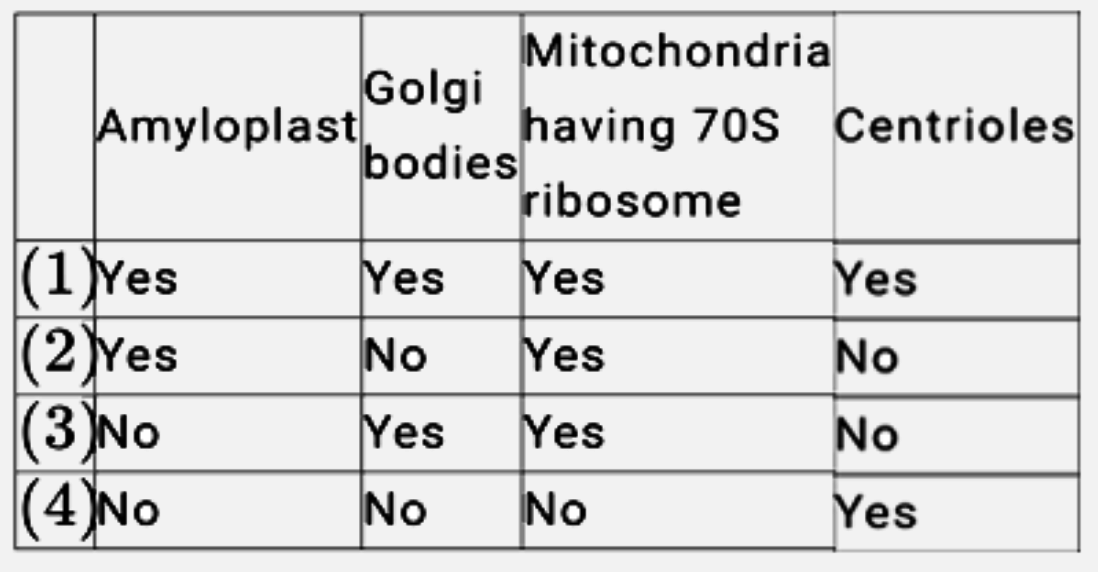Some features of cells are listed. Which features can be found both in plant cells and prokaryotic cells?
I. Cell wall
II. Cell surface membrane
III. Ribosome
I and III only
II and III only
I and III only
I, II and III
The correct Answer is:D
To solve the question regarding which features can be found both in plant cells and prokaryotic cells, we will analyze each of the listed features one by one.
1. Identify the Features:
- The features listed are:
I. Cell wall
II. Cell surface membrane
III. Ribosome
2. Analyze Feature I: Cell Wall
- Plant cells have a rigid cell wall made of cellulose.
- Prokaryotic cells (such as bacteria) also have a cell wall, which is typically made of peptidoglycan.
- Conclusion: The cell wall is present in both plant cells and prokaryotic cells.
3. Analyze Feature II: Cell Surface Membrane
- Both plant cells and prokaryotic cells have a cell surface membrane (also known as the plasma membrane).
- The cell surface membrane functions to protect the cell and regulate what enters and exits.
- Conclusion: The cell surface membrane is present in both plant cells and prokaryotic cells.
4. Analyze Feature III: Ribosome
- Ribosomes are the sites of protein synthesis.
- They are present in all living cells, including both eukaryotic cells (like plant cells) and prokaryotic cells.
- Eukaryotic ribosomes are larger (80S) compared to prokaryotic ribosomes (70S), but both types perform the same function.
- Conclusion: Ribosomes are present in both plant cells and prokaryotic cells.
5. Final Conclusion:
- All three features (cell wall, cell surface membrane, and ribosome) are found in both plant cells and prokaryotic cells.
- Therefore, the correct answer is I, II, and III.
- The features listed are:
I. Cell wall
II. Cell surface membrane
III. Ribosome
- Plant cells have a rigid cell wall made of cellulose.
- Prokaryotic cells (such as bacteria) also have a cell wall, which is typically made of peptidoglycan.
- Conclusion: The cell wall is present in both plant cells and prokaryotic cells.
- Both plant cells and prokaryotic cells have a cell surface membrane (also known as the plasma membrane).
- The cell surface membrane functions to protect the cell and regulate what enters and exits.
- Conclusion: The cell surface membrane is present in both plant cells and prokaryotic cells.
- Ribosomes are the sites of protein synthesis.
- They are present in all living cells, including both eukaryotic cells (like plant cells) and prokaryotic cells.
- Eukaryotic ribosomes are larger (80S) compared to prokaryotic ribosomes (70S), but both types perform the same function.
- Conclusion: Ribosomes are present in both plant cells and prokaryotic cells.
- All three features (cell wall, cell surface membrane, and ribosome) are found in both plant cells and prokaryotic cells.
- Therefore, the correct answer is I, II, and III.
Similar Questions
Knowledge Check
Unlike eukaryotic cells, prokaryotic cells :
Alack a plasma membraneBdo not have a nucleusChave RNA, not DNADall of the above
what is the function of cell wall in a prokaryotic cell?
View SolutionWhich of the following structures is found only in a prokaryotic cell?
View SolutionMention the common features shared by plant cells and animal cells.
View SolutionSelect the features that are common to animal and plant cells ?

View SolutionWhich of the following structures is not found in a prokaryotic cell?
View SolutionWhich one occurs in both prokaryotic and plant cells ?
View SolutionThe only organelle found in a prokaryotic cell is
View Solution
